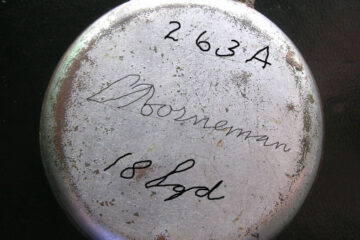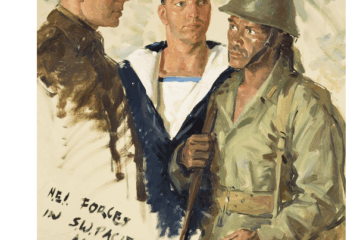A large part of the KNIL was captured in Java, but several senior officers, support staff, and special units made it to Australia. Others remained behind to continue guerrilla operations, notably in Timor and Dutch New Guinea.
This article doesn’t pretend to name all the Dutch and NEI people who ended up in Australia, but we believe it contains the names of most of the key individuals. The same applies to the ships and aircraft mentioned. It offers a snapshot of what and who arrived by March 1942, forming the backbone of Dutch military, civil, and diplomatic operations in exile. Based primarily on Jack Ford’s Allies in a Bind (Chapter 3), this inventory reflects the extraordinary efforts undertaken to re-establish Dutch authority and coordination on Australian soil after the fall of the NEI.
Army: Royal Netherlands East Indies Army (KNIL)
Key figures in Australia:
- Major General Ludolph van Oyen – Acting Commander-in-Chief of KNIL in exile
- Lieutenant General Simon Hendrik Spoor – Senior staff officer; liaison to Allied SWPA command
- Major General C. A. H. Salm – Adviser on organisational matters
- Colonel G. C. E. van Daalen – Logistics and mobilisation
- Lt. Colonel C. C. H. Janssen – Operations coordination
- Lt. Colonel C. F. Vischer – Military attaché in Canberra
- Major A. J. Berghuis – Coastal defence and artillery
- Captain G. G. M. van Areken – Staff officer
- Captain H. Molenbrugge – Operations
- Captain L. B. N. Edwards van Muyen – Planning and transport
- Lieutenant B. Brot – Junior command
- Sergeant John Tahija – Indo-European NCO, later postwar intelligence and political figure
Guerrilla operations:
KNIL troops continued fighting alongside Australian Sparrow Force on Timor. Small units resisted in New Guinea, maintaining radio contact with Dutch authorities in exile.
Facilities:
Darley Camp in Victoria served as an initial regrouping centre. Later, training and housing facilities were established at Camp Casino (NSW) and other sites.
Navy: Royal Netherlands Navy (RNN)
The Royal Netherlands Navy suffered heavy losses in the Battle of the Java Sea, but many vessels and personnel regrouped in Australia, mainly in Fremantle, Brisbane, and Melbourne.
Key officers:
- Rear Admiral Frederik Willem Coster – Head of Netherlands Purchasing Commission
- Commander J. A. F. H. Douw van der Krap – Combat command and reorganisation
- Commander B. J. Knollema – Naval personnel administration
- Commander A. Haitsma – Harbour logistics
- Lieutenant Commander H. J. Landsman – Liaison operations
- Lieutenant H. Gilles and Lieutenant Kruyswyk – Junior officers
- Lieutenant A. M. Idema and Lieutenant R. J. Hordijk – Submarine officers who escaped Japanese POW camps
Naval assets in Australia:
- Cruiser: HNLMS Tromp (flagship), Sumatra (left for Britain), Jacob van Heemskerk (arrived 6 March, sent to British Eastern Fleet)
- Submarines: O-19, K-XIV, K-XV, K-VIII, K-IX, K-XI, K-XII (Fremantle-based)
- Minesweepers: Abraham Crijnssen, Merbaboe, Smeroe, Rindjani (80 tons each)
- Gunboat: Soemba
- Minelayer: Willem van der Zaan
- Auxiliary vessels: Claudius (oiler), Columbia (submarine depot ship carrying Princess Irene Brigade), Zuiderkruis (supply), Hydrograff (survey)
Naval personnel also formed the basis of a new Marine Armoured Battalion. This unit, initially assembled in Australia, was later transferred to the United States and expanded into the Mariniersbrigade—a Dutch amphibious force trained in Camp Lejeune and Camp Davis in North Carolina.
Air Force: ML-KNIL, MLD, KNILM
Evacuated aircraft and crews formed the basis of NEI air operations in exile. Coordination occurred from Archerfield (Brisbane) and later formed No. 19 (NEI) Squadron RAAF.
Key personnel:
- Lt. Colonel F. C. J. Kuyper – ML-KNIL liaison
- Captain A. J. B. Kuipers – RAAF coordination
- Lieutenant J. Brunsting – Transport pilot
- Lieutenant Meijnderts – Air operations
- Gus Winckel – KNILM pilot who fired at attacking Zeros over Broome with a pistol from cockpit
- Ivan Smirnoff – Evacuated DC-3 “Pelikaan” crew, shot down over Broome
- Captain Wittert van Hooghland – Commander of NEI B-25 bomber squadron
Aircraft in Australia:
- Lockheed Lodestars and Model 12s
- Douglas DC-2s, DC-3s, and DC-5s (ex-KNILM)
- Do 24 flying boats
- Mitchell B-25 bombers (USA-supplied)
- Catalinas X-18, X-24 and others
Aircraft in Ceylon:
- Catalinas Y-55, Y-56, Y-57, Y-64
- Lodestar L-201 – Last aircraft to leave Java
- B-25 bombers (8), ferried from USA to Ceylon
Merchant Fleet and Government Shipping
A major component of the Dutch escape was the merchant fleet. By March 1942, at least 27 Dutch KPM (Koninklijke Pakketvaart Maatschappij) and SMN (Stoomvaart Maatschappij Nederland) ships had reached Australia, often rerouted while at sea. The Netherlands Indies Government Shipping Service (NIGSS) was formed from these ships.
Key ships:
- Bontekoe, Van Heutsz, Van Heemskerk, Bantam
- Generaal Verspijck, Zaandam, Marella, Mongola
- Plancius – converted to submarine depot ship
- Kota Baroe – evacuated cadets to Ceylon
- Ophir and Melchoir Treuh – converted to hospital ships (Bombay)
Dutch ships also played a major role in Convoy ZK8, delivering Australian troops to Port Moresby in May 1942. Others joined Operation Lilliput convoys supporting Allied landings in Papua.
Civil Administration and Business Evacuees
Key personnel and institutions of the NEI Government-in-Exile regrouped in Australia, particularly in Melbourne and later Brisbane (Camp Columbia).
Notable evacuees and officials:
- Hubertus J. van Mook – Lieutenant Governor-General designate
- Charles van der Plas – Director of the Interior
- J. C. van Helsdingen – Secretary of the Interior
- J. J. A. Spoor – Military attaché
- A. H. J. Lovink – Director of Economic Affairs
- G. Schuurman – President of the Postal Bank
- H. J. van Weerden Poelman – Political intelligence
- J. L. Rens – Economic liaison
- G. M. Versluys – Director of Geo. Wehry & Co.
- G. Schepers – KPM executive
- F. K. Posthuma – Chamber of Commerce
- J. A. Latuharhary and Iskander Tedjasukmana – Indonesian nationalist legal advisers
Ships used in evacuation of civilians and staff:
- Mongola
- Bantam
- Zaandam
- Marella
- Generaal Verspijck
Many of these ships arrived between late February and mid-March 1942.
Diplomatic Presence
- Baron François Cornelis van Aerssen Beijeren van Voshol – First Dutch Envoy to Australia (April 1942)
- H. Craandijk – Acting Consul in Sydney
- Dutch purchasing mission under Coster and van Holst-Pellekaan operated from Melbourne
Related articles
- Between secrecy and survival: Australia’s frustration with Dutch neutrality on the eve of war
How Dutch hopes of neutrality and secrecy clashed with Australia’s urgent need for regional defence cooperation in 1941. - Divided in exile: tensions between Batavia and London in the Dutch war effort
The fractured wartime relationship between the Dutch government-in-exile in London and the autonomous NEI administration in Batavia. - Reform or restoration? Political tensions over the future of the Netherlands East Indies during wartime exile
The ideological rift between Dutch reformers like Van Mook and colonial traditionalists in exile, and how these shaped Allied relations. - Wartime reform and Indonesian voices: Dutch–Indonesian political tensions in exile
Indonesian aspirations and Indo-Dutch reformist voices during exile—and how these were received by both Dutch and Allied leaders. - The Dutch purchasing mission and wartime supply issues in Australia
Administrative roadblocks, discriminatory policies, and cultural tensions that strained Dutch experiences in wartime Australia. - From indifference to diplomacy: how the war transformed Dutch–Australian foreign relations
How a war of necessity forced two formerly disconnected countries into direct cooperation, setting the stage for postwar transformation.
Sources
Jack Ford, Allies in a Bind: Australia and the Netherlands East Indies in the Second World War, CQU Press, 2001


